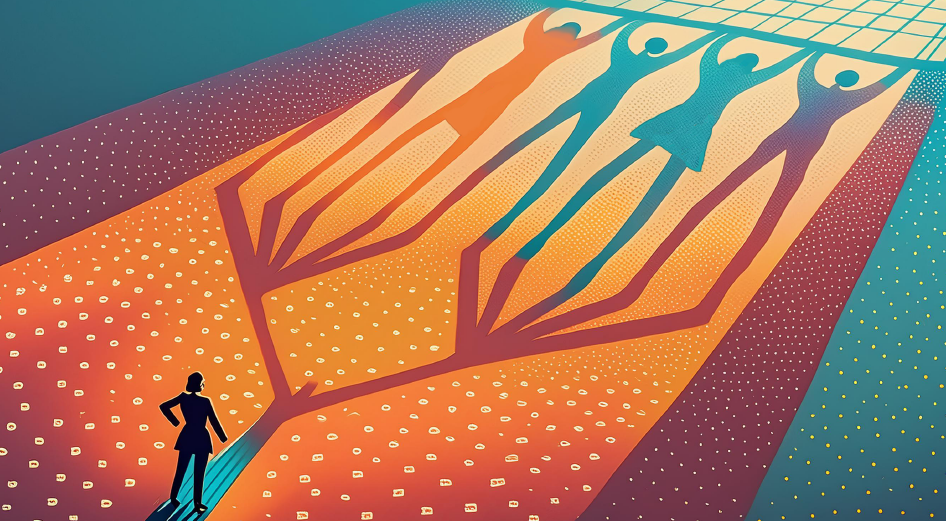Ask Google when influencer marketing first became a thing, and you’ll find several origin stories. There are early 20th-century examples from brands like Coca-Cola and Coco Chanel. There’s the story of Josiah Wedgwood, who used endorsements from the British royal family to promote his pottery business in 1760. Some sources even cite examples dating to ancient Rome.
Influencer marketing isn’t new, and it certainly didn’t start with social media. But while you typically associate influencers with B2C marketing, they play a big role in B2B as well. A 2023 Ogilvy report found that 75% of B2B businesses use influencer marketing, and more than half of the remaining 25% plan to do so.
The question, then, isn’t whether B2B brands see the value of engaging influencers to help further their content marketing goals but who they are partnering with. How are they positioning their initiatives to achieve success?
Micro-influence and multiple funnel stages
One school of thought holds that B2B influencer campaigns should focus on driving awareness at the top of the funnel. Consider the experience of Wendy Covey, CEO and co-founder of TREW Marketing and host of the podcast Content Marketing, Engineered.
“The ultimate goal of the B2B influencer is to make sure their brand is top of mind when a prospect is ready to talk to sales rather than to drive a transaction in the moment,” Wendy says. “B2B influencers are thought leaders — buyers look to them for information about the history and trajectory of their industry, answers to challenging problems, and insight on how to stay ahead of the trends.”
B2B marketers tap into the trusting and enduring relationships an influencer has built with their target audience. It’s a good fit because trust builds over time, and B2B sales cycles typically run 12 to 24 months. That’s why Wendy tells B2B clients that influencer marketing is all about building the brand.
Others argue that B2B influencers can do more than raise brand awareness.
“Think of influencers [as a value-add] at every stage of the funnel,” says Tim Davidson, a B2B content creator and vice president of marketing and founder of B2B Rizz. “What changes is how you use the influencer.”
Like Wendy, Tim agrees that top-of-the-funnel engagements are all about awareness. In the middle of the funnel, Tim sees customers talking about their experience with the brand’s product as an influencer play that helps pull prospects into higher-level conversations.
Influencers also can fuel marketing goals at the bottom of the funnel. “Assuming the person you’re working with is a subject matter expert, [and] if they’re open to it, try and have them on sales calls, or make introductions to help move potential deals along,” Tim says.
Why do the takes conflict? Well, when Ogilvy asked B2B marketers where influencers had the biggest impact on the funnel, they found an even split between those who touted its sales benefits and those who felt it works best for forging relationships and increasing awareness.
But when it comes to the size of the B2B funnel, Tim and Wendy agree that bigger influencer audiences aren’t necessarily better.
“It’s much more important to have the right audience — likely the [people] who are informing or driving purchase decisions later in the buying cycle,” Wendy says.
According to Tim, the size of an influencer’s audience should correlate to the size of the total addressable market. Having multiple millions of followers may not be essential for an effective B2B engagement, and it may be a big red flag.
“It’s actually quite easy to game the algorithms with very broad content, engagement pods, and buying followers,” Tim says.
That means you may not get the reach you expect from your chosen influencer partner(s) — a compelling reason to consider building your strategy on internal expertise.
Building your influence vs. buying it on the open market
B2B influencers come in two flavors: internal and external. Often, B2B marketers will use a mix, but each has a role to play, says Pam Didner, a B2B marketer, author, and speaker.
“Internal influencers should be subject matter experts,” she says. “An external influencer is a thought leader in your space — someone you want to collaborate with.”
Collaborations with thought leaders can be tricky, though, in part because thought leaders have their own business needs to consider. That’s why it’s important for B2B marketers to put a lot of care into screening and preparing the influencer for their campaigns.
“With [external] thought leaders, you really want to understand their expertise, where they shine, and how your brand can leverage their expertise to amplify your message,” Pam says. “You need to have a very in-depth conversation.”
At the other end of the spectrum, developing influencers internally makes it easier to scale cadence and align their efforts with your brand’s goals. But it’s important for companies to inspire and support employees who agree to serve as influencers.
“People care more about [how being an influencer] impacts their career rather than the business,” Tim says. “[You have to] show how being known as an expert impacts them and the opportunities they have.”
Even if content creation and external-facing roles come naturally to in-house influencers, it helps to invest in education and training. That can mean hiring a ghostwriter to level up the copy in their articles and op-eds and provide technical specialists to help in-house influencers produce professional-quality podcasts and videos. Just as important, leaders should recognize that influencing is work.
“Give people time to post and create,” Tim says. “If you expect them to do it on top of everything else, they simply won’t have enough time, and it’ll always get de-prioritized.”
If there’s one commonly misunderstood aspect about in-house influencers, it’s that someone will use the opportunity to build their personal brand and leave the company.
“We largely find that in B2B companies, this just isn’t the norm,” Wendy says. “First, if someone’s built thought leadership for your company, it’s a reasonable expectation that they can pass that torch to another person in the company. [Also], a good thought leader [is] someone who has successfully grown their own influence while advocating for your company, [so they don’t] typically leave on bad terms. More often, they will become an external influencer for your organization.”
Social still factors into B2B influence
Historically, B2B marketers have pitched their influencers as speakers at industry events and guest authors for trade media articles. But as media consumption evolves, B2B marketers have evolved, too.
“Events and trade publications still matter,” says Allison Champion, senior director and head of marketing communications at Flowspace, an e-commerce fulfillment platform. “But the reach of those platforms is declining, in part because the conversation is happening on LinkedIn and other places.”
While B2B influencer marketing may not be as social media dependent as its B2C counterpart, LinkedIn is a notable exception. To tap into relevant conversations on LinkedIn, Allison treats influencers like traditional media, inviting them to briefings and pitching story ideas.
“B2B influencers are more approachable than press because they’re eager to build their networks,” Allison says.
Pam has a name for this tactic — influencing the influencer.
“Provide them with early scoops, inside information, research, access to your thought leaders, and more,” Pam says. “This will help them position themselves as an industry-forward pundit and bring your brand along for the ride.”
While influencing the influencer often involves LinkedIn, the reality is that the platform doesn’t capture the entire audience. Part of the reason for that is media fragmentation. Another factor is the way B2B spaces are changing, thanks to digital tools, new platforms, and remote work.
To reach customer personas that might not show up in traditional spaces, Allison recently began hosting a Flowspace podcast called Stories from the Shelf.
“We want to be a forum for conversations in the fulfillment space,” Allison says. “Our guests are the influencers, and we invite logistics and operations leaders to tell stories about how brands grow, scale, and move the needle.”
Done well, podcasts open the door for influencers and subject matter experts to share their candid experiences. Case in point: the gap between the way brands in the logistics space talk about Excel and what influencers say on podcasts.
“It’s a big trope in the logistics trade press and company blogs to say that Excel is outdated,” Allison says. “But when you talk to influencers, you learn that everyone uses Excel, and what [customers] really want is better Excel integrations from their other tools.”
While influencer marketing campaigns don’t necessarily bring insights to the product team, Allison’s experience isn’t unique. In an episode of Content Marketing, Engineered, the marketing team at Heatcraft Refrigeration Products told Wendy their YouTube influencer Chris (who does not share their last name on their accounts) has helped them troubleshoot quality issues, improve products, and close the loop between product, manufacturing, and customers.
But even if social listening doesn’t directly impact your products, it absolutely improves content.
“If all you’re doing is curating your own ideas and posting, shouting, and pitching yourself as an expert, your campaign won’t be sustainable because you’ll be out of touch quickly,” Wendy says. “When you think about engaging, listen twice for every time you speak.”
Build, buy, or barter?
It’s impossible to talk about influencers without discussing compensation. Employee influencers typically aren’t paid extra, although they might receive small perks like gift cards. With external influencers, each situation is different.
“There are many ways to work with influencers,” Pam says. “There’s paid, barter, or you can just send them [the product]. The important thing is that it has to be organic.”
If you are paying influencers, don’t expect a standard rate.
“It’s the Wild West right now in B2B,” Tim says. “It’s all negotiable, so payment will be different from one influencer to the next.”
But there’s a big difference between paying an influencer and treating it as a transaction. Payment, after all, is a normal part of any business. But transactional engagements probably won’t feel organic or authentic to the audience.
“Many [B2B influencers] are motivated by benefits from your company that help grow their business rather than a generic transactional relationship,” Wendy says. “These benefits may include early access to products, behind-the-scenes tours, a trade show demo in your booth, or elevated support. Ask lots of questions to uncover points of synergy and then think out-of-the-box when it comes to how they will support your brand, and vice versa.”
But is it better to hire influencers or develop them in-house? Like so many things, the answer is that it depends on your brand’s resources and priorities.
“You’ll have much more control by growing an influencer internally,” Wendy says, “but if your brand is not well known and you don’t have a community, an external influencer may be just the jump-start you need.”

